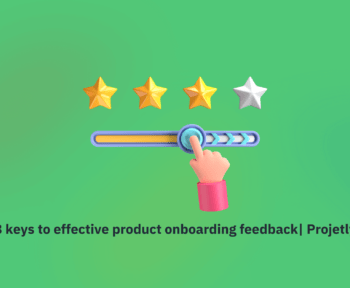With the rise of digitalization, remote customer onboarding has become an integral part of modern businesses. It’s a game-changer that allows companies to onboard customers from anywhere in the world. Whether you’re a startup or a well-established business, remote onboarding enables you to reach a wider audience while providing a seamless customer experience. If you’re looking to stay ahead of the curve, embracing remote customer onboarding is the way to go!
Remote onboarding refers to welcoming and guiding new customers through their journey with your company without the need for physical interaction. Remote customer onboarding is essential for businesses operating online or with a distributed customer base. It helps sets the tone for customer experience and significantly builds long-term client relationships.
Table of Contents

The importance of a seamless customer onboarding process
A seamless customer onboarding process is the foundation of a successful business. It is your customers’ first impression of your company and sets the stage for their entire journey with you. A smooth onboarding experience can increase customer satisfaction, loyalty, and retention rates. On the other hand, a confusing or cumbersome onboarding process can create frustration and cause customers to abandon your services before they even get started. Therefore, investing time and effort into perfecting your remote customer onboarding process is crucial.
Related blog: How To Leverage SaaS Onboarding – 12 Best Practices For 2024 Success
Challenges of remote customer onboarding
While remote customer onboarding offers numerous benefits, it has its fair share of challenges. One of the main obstacles is the need for face-to-face interaction. Establishing trust and rapport with new clients can be challenging without physical presence.
Additionally, the absence of non-verbal cues can make it difficult to accurately gauge customers’ emotions and needs. Moreover, technical issues, such as poor internet connectivity or unfamiliarity with digital platforms, can further complicate the onboarding process. However, by understanding these challenges and implementing effective strategies, you can overcome them and provide an exceptional onboarding experience.
Building trust in remote interactions requires specific strategies. A Harvard Business Review article offers valuable insights on this topic: The article ‘New to the Team? Here’s How to Build Trust (Remotely)‘ highlights the importance of frequent communication, clear expectations, and fostering a sense of connection through virtual interactions.
Eight expert tips for successful remote customer onboarding
Building a personalized onboarding experience remains critical to creating a memorable customer experience. However, here are eight expert tips to take your remote customer onboarding to the next level:
- Building a personalized onboarding experience: Personalization is critical to creating a memorable onboarding experience for your customers. Start by gathering relevant information about your new clients during the signup process. Use this data to tailor your onboarding process to their needs and preferences. Welcome emails, personalized video messages, and customized tutorials are some ways to make your customers feel valued from the beginning.
- Utilizing technology for remote customer onboarding: Embrace technology to streamline your onboarding process—leverage video conferencing tools to conduct virtual meetings and training sessions. Use screen-sharing capabilities to guide customers through your platform and demonstrate key features. A user-friendly customer portal or knowledge base can empower customers to independently self-serve and find answers to their questions.
- Communication and collaboration during the onboarding process: Maintaining open lines of communication is crucial during the remote customer onboarding process. Regularly check in with your clients to address any concerns or questions they may have. Utilize various communication channels, such as email, instant messaging, or phone calls, to ensure accessibility and cater to different preferences—Foster collaboration through online forums or virtual events for customers to interact with your team and other users.
- Measuring success and optimizing the onboarding experience: It is essential to measure success and gather feedback to ensure the effectiveness of your remote customer onboarding process. Monitor key metrics, such as time to onboard, customer satisfaction scores, and retention rates, to evaluate the impact of your efforts. Encourage customers to provide feedback through surveys or interviews and use their input to identify areas for improvement. Optimize your onboarding experience based on these insights to deliver an exceptional customer journey.
- Providing clear and concise resources: Supplement your onboarding process with clear and concise resources that customers can access on-demand. This could include user manuals, FAQs, video tutorials, or step-by-step guides. Make these resources easily accessible through a centralized location, such as a customer portal or knowledge base.
- Encouraging self-service: Empower your customers to onboard themselves at their own pace by providing self-service options. This could include an interactive onboarding platform, a comprehensive knowledge base, or chatbots that can answer frequently asked questions.
- Promoting user engagement: Go beyond simply providing information and encourage active participation from your customers during onboarding. This could involve interactive quizzes, gamified tutorials, or opportunities for customers to practice using your product or service.
- Celebrating milestones and successes: Acknowledge and celebrate your customers’ milestones throughout the onboarding journey. This could involve sending congratulatory emails after completing key steps, offering rewards for completing the onboarding process or recognizing customers who become proficient users of your product or service.

Best practices for remote customer onboarding
In addition to the expert tips mentioned above, here are some best practices to enhance your remote customer onboarding process:
- Simplify the signup process: Make it easy for customers to register and get started with your services. Minimize the number of steps and eliminate unnecessary form fields.
- Provide comprehensive onboarding materials: Offer detailed tutorials, user guides, and FAQs to guide customers through your platform. Ensure these resources are easily accessible and regularly updated.
- Assign a dedicated onboarding specialist: A designated point of contact can significantly improve the onboarding experience. This specialist can provide personalized support and address any specific needs or concerns.
- Offer ongoing training and support: Even after the initial onboarding phase, continue to provide resources and assistance to help customers maximize the value of your product or service. This can include webinars, knowledge base articles, or one-on-one training sessions.
Conclusion
Mastering the art of remote customer onboarding is crucial for businesses looking to provide a seamless and exceptional customer experience. Understanding the challenges, implementing expert tips, and following best practices can elevate your onboarding process and build strong client relationships. Remember, remote customer onboarding is not just a one-time event but an ongoing journey that requires continuous improvement and adaptation.
Embrace technology, personalize the experience, and prioritize communication to ensure your customers feel valued and supported from day one. Start implementing these strategies today, and watch your customer satisfaction and retention soar.
Frequently Asked Questions
-
What is remote onboarding and why is it essential for customer success?
Remote onboarding refers to the process of welcoming and integrating new customers into your product or service through virtual means, without face-to-face interaction. It is essential for customer success because it ensures that customers can understand, access, and fully utilize your product or service regardless of their location. Effective remote onboarding can enhance customer satisfaction, reduce churn rates, and foster long-term loyalty.
-
How can clear communication improve the remote onboarding process?
Clear communication is vital in remote onboarding to ensure that customers understand each step of the process and the value of your product. This includes providing comprehensive and straightforward instructions, offering regular updates, and being readily available to answer questions. Utilizing various communication channels, such as emails, video calls, and chat, helps maintain engagement and ensures that customers feel supported throughout their onboarding journey.
-
What role do interactive tutorials and demos play in remote onboarding?
Interactive tutorials and demos are instrumental in remote onboarding as they provide hands-on experience and real-time understanding of your product. These tools allow customers to explore features and functionalities at their own pace, making the learning process more engaging and effective. By simulating real-world usage, interactive tutorials and demos help customers build confidence in using your product, leading to quicker adoption and satisfaction.
-
Why is personalized support crucial in remote onboarding?
Personalized support is crucial in remote onboarding as it addresses the unique needs and challenges of each customer. Offering tailored assistance through dedicated onboarding specialists or customized resources helps customers overcome specific obstacles and achieve their goals faster. Personalized support fosters a sense of connection and trust, making customers feel valued and increasing their likelihood of becoming loyal advocates for your brand.





1 Comment